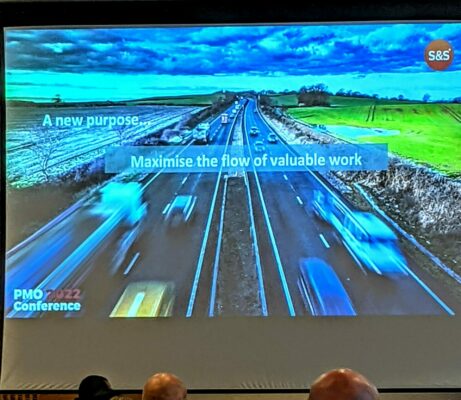
1. Start by aligning strategy to execution
A theme that is close to hearts here at Kiplot! We were delighted to hear that the opening keynote speaker (Laura Barnard) chose to focus on this, arguing that the role of the modern PMO is to act as the orchestration layer, that connects strategy to execution on an ongoing basis.
Stop thinking about tracking, reporting templates, governance, controls and standards. Start thinking about prioritisation, strategic alignment, value creation, removing dependencies, and empowering teams.


71% of projects are not aligned to company's strategy.
2. Focus on overall productivity, not on resource utilisation
Adrian Stalham gave a provocative talk on the importance of focusing on maximizing productivity (or “flow”). He pointed out that in many organisations, this is likely to be at odds with the philosophy of maximizing utilization.
The reason that maximising utilisation isn’t your nirvana, is because of the problem of context switching (at scale). Context switching occurs every time you stop doing something (before you finish it) and do something else. That’s every time you half write an email, and then start reading the next one. Or every time you start preparing for a meeting, and get interrupted to go to an “urgent” meeting. At organisational scale, context switching can suffocate an organisation’s productivity.
Multiple studies have shown the significant cost of context switching, reporting that it can cost 40% of your productivity. What would you do with an extra 40% of your week? That’s the equivalent of an extra 2 days in the week – for your entire organisation!
Adrian brought this to life using an example. Imagine timing how long it takes for someone in your team to complete a specific task. Let’s take writing an email as an example. Let’s say it takes them 1 minute.
You can then assume that if they write that same email 10 times, sequentially (one after the other), it will take them around 10 minutes (let’s pretend copy + paste doesn’t exist).
However, if you ask them to write that same email 10 times, but rather than doing it sequentially, you get them to attempt to write them all at the same time, switching between tabs as they write one word within each email, it will take them much longer than 10 minutes to complete the activity.
While this example might seem silly – it perfectly illustrates what happens when you load up teams to maximum utilization. Pursuing fewer initiatives and underutilizing your organization may actually result in greater output than stacking your teams up with a list of initiatives that maximise their utilisation.
The sketch below illustrates this concept:
Do less to achieve more.

Finding your optimum utilization point requires you to measure flow metrics.

3. Organisations have (finally!) begun to focus on agility, rather than Agile
Over the last few years, there has been a preoccupation with questions about the discipline of Agile, its jargon, its training courses and its various flavours. Based on the great conversations we had on the day, organisations have begun to refocus on the broader objective – to get closer to the customer, while increasing the speed, efficiency and quality of the change that they deliver.
As a result, we had some fantastic discussions. At our stand, some of the best questions and conversation themes from the day were:
“How do I best organize my teams to reduce dependencies and concentrate expertise?”
“How do I adapt our investment governance processes to better support continuous prioritization and continuous iteration, while keeping the CFO happy?”
“How can I introduce greater empowerment to teams, while ensuring they remain aligned to our strategy?”
“How do I minimize reporting, but maximise data driven decision making?”
“How do I measure productivity?”
Focus on agility, not on Agile.

